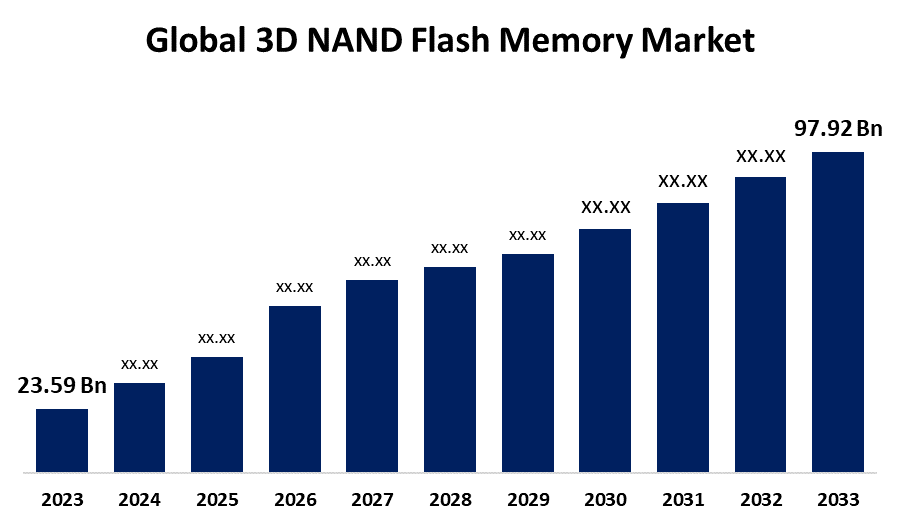Global 3D NAND Flash Memory Market Size, Share, and COVID-19 Impact Analysis, By Type (Single-level Cell, Multi-level Cell, and Triple-level Cell), By Application (Camera, Laptops & PCs, and Smartphones & Tablets), By End Use (Automotive, Consumer Electronics, Enterprise, and Healthcare), and By Region (North America, Europe, Asia-Pacific, Latin America, Middle East, and Africa), Analysis and Forecast 2023 - 2033
Industry: Semiconductors & ElectronicsGlobal 3D NAND Flash Memory Market Insights Forecasts to 2033
- The Global 3D NAND Flash Memory Market Size was Estimated at USD 23.59 Billion in 2023
- The Market Size is Expected to Grow at a CAGR of around 15.3% from 2023 to 2033
- The Worldwide 3D NAND Flash Memory Market Size is Expected to Reach USD 97.92 Billion by 2033
- North America is Expected to Grow the fastest during the forecast period.

Get more details on this report -
The Global 3D NAND Flash Memory Market Size was worth around USD 23.59 Billion in 2023 and is predicted to Grow to around USD 97.92 Billion by 2033 with a compound annual growth rate (CAGR) of around 15.3% between 2023 and 2033. The rapid influx of smartphones, tablets, and notebooks in the market is expected to be the key driving force for this industry.
Market Overview
3D NAND flash memory is a non-volatile storage technology that stores memory cells in vertically stacked multiple layers to maximize storage capacity and performance while minimizing physical space. The technology enhances speed, endurance, and power efficiency over the conventional 2D NAND flash memory, thus it is widely utilized in applications including solid-state drives (SSDs), smartphones, and other electronics. 3D NAND technology offers benefits including lower data access speeds, higher capacities, and improved energy efficiency compared to previous memory technologies. Furthermore, the rapid expansion of data centers and the increasing popularity of cloud services also drive the demand for enhanced memory solutions to be able to handle the growing volume of data. Additionally, the 3D NAND manufacturing process is simpler than other technologies, such as RRAM, because it uses the same materials employed in making NAND, whereas FRAM, MRAM, RRAM, and others use new materials that are poorly researched and understood. Furthermore, they are embedded in many consumers' electronic devices and enterprise applications.
Report Coverage
This research report categorizes the global 3D NAND flash memory market based on various segments and regions forecasts revenue growth and analyzes trends in each submarket. The report analyses the key growth drivers, opportunities, and challenges influencing the global 3D NAND flash memory market. Recent market developments and competitive strategies such as expansion, type launch, development, partnership, merger, and acquisition have been included to draw the competitive landscape in the market. The report strategically identifies and profiles the key market players and analyses their core competencies in each sub-segment of the global 3D NAND flash memory market.
3D NAND Flash Memory Market Report Coverage
| Report Coverage | Details |
|---|---|
| Base Year: | 2023 |
| Market Size in 2023 : | USD 23.59 Billion |
| Forecast Period: | 2023-2033 |
| Forecast Period CAGR 2023-2033 : | 15.3% |
| 2033 Value Projection: | USD 97.92 Billion |
| Historical Data for: | 2019-2022 |
| No. of Pages: | 236 |
| Tables, Charts & Figures: | 110 |
| Segments covered: | By Type, By Application, By End Use |
| Companies covered:: | Samsung Electronics Co., Ltd., Intel Corporation, Toshiba Memory Corporation, Western Digital Corporation, Micron Technology Inc., SK Hynix Inc., Kingston Technology Company, Inc., Crucial Technology, SanDisk Corporation, Transcend Information Inc., and Others. |
| Pitfalls & Challenges: | Covid-19 Empact, Challenges, Growth, Analysis. |
Get more details on this report -
Driving Factors
The rapid surge of smartphones, tablets, and notebooks in the market is likely to be the major driving force for this industry. Notebook manufacturers have started incorporating this technology in some of the high-end notebooks that they sell. Growing demand for data storage devices with huge storage capacities is likely to propel this 3D NAND flash memory market. The increasing need for high-performance computers utilized in programming, monitoring, gaming, and other critical domains is also likely to drive the growth of this 3D NAND flash memory market.
Restraining Factors
Continued development in 3D NAND technology demands heavy R&D investments, which can put a burden on finances, particularly for smaller players. The issue of scaling up the production without compromising on quality is also a major challenge.
Market Segmentation
The global 3D NAND flash memory market share is classified into type, application, and end use.
- The triple-level cell segment accounted for a significant share in 2023 and is projected to grow at the fastest CAGR during the forecast period.
Based on type, the global 3D NAND flash memory market is divided into single-level cell, multi-level cell, and triple-level cell. Among these, the triple-level cell segment accounted for a significant share in 2023 and is projected to grow at the fastest CAGR during the forecast period. The growth of the segment is fueled by its cost-effectiveness, technological innovation, and increasing demand for high-capacity storage. TLC is widely used by NAND flash manufacturers with 3D NAND flash, where the memory cells are vertically stacked on the chip.
- The smartphones & tablets segment accounted for the largest revenue share in 2023 and is anticipated to grow at a significant CAGR during the forecast period.
Based on application, the global 3D NAND flash memory market is divided into camera, laptops & PCs, and smartphones & tablets. Among these, the smartphones & tablets segment accounted for the largest revenue share in 2023 and is anticipated to grow at a significant CAGR during the forecast period. The segment growth is driven because smartphones and tablets are increasingly applying AI and machine learning capabilities for applications such as facial recognition, voice assistance, and live language translation. These applications entail intensive data processing as well as storage space in the storage of multiple applications.
- The consumer electronics segment accounted for the leading revenue share in 2023 and is anticipated to grow at a remarkable CAGR during the forecast period.
Based on end use, the global 3D NAND flash memory market is divided into automotive, consumer electronics, enterprise, and healthcare. Among these, the consumer electronics segment accounted for the leading revenue share in 2023 and is anticipated to grow at a remarkable CAGR during the forecast period. The segment growth is largely fueled by the rising need for high-storage and efficient capabilities in devices ranging from smartphones and tablets to laptops and cameras. The demand for faster data retrieval and technological breakthroughs continues driving the use of 3D NAND flash memory in consumer appliances.
Regional Segment Analysis of the Global 3D NAND Flash Memory Market
- North America (U.S., Canada, Mexico)
- Europe (Germany, France, U.K., Italy, Spain, Rest of Europe)
- Asia-Pacific (China, Japan, India, Rest of APAC)
- South America (Brazil and the Rest of South America)
- The Middle East and Africa (UAE, South Africa, Rest of MEA)
Asia Pacific is anticipated to hold the largest share of the global 3D NAND flash memory market over the predicted timeframe.

Get more details on this report -
Asia Pacific is anticipated to hold the largest share of the global 3D NAND flash memory market over the predicted timeframe. The growth of the region can be attributed to the presence of major semiconductor manufacturers like Samsung, SK Hynix, and Micron Technology. The region's consumer electronics market, encompassing smartphones, tablets, and laptops, is expanding rapidly, creating a need for new-age storage solutions. The development of 3D NAND technology in countries like South Korea, Japan, and China is being driven by the high focus on innovation and research and development investments in the semiconductor sector in this region.
North America is expected to grow at the fastest CAGR in the global 3D NAND flash memory market during the forecast period. The regional growth can be attributed to the demand for high-performance SSDs rising to support cloud services, IoT devices, and high-performance computing needs. Additionally, in North America, organizations such as Intel and Western Digital are investing heavily to enhance 3D NAND technology. The growing IoT network and increasing data consumption also contribute to the rapid adoption of advanced memory solutions in the region.
Competitive Analysis:
The report offers the appropriate analysis of the key organizations/companies involved within the global 3D NAND flash memory market along with a comparative evaluation primarily based on their type of offering, business overviews, geographic presence, enterprise strategies, segment market share, and SWOT analysis. The report also provides an elaborative analysis focusing on the current news and developments of the companies, which includes type development, innovations, joint ventures, partnerships, mergers & acquisitions, strategic alliances, and others. This allows for the evaluation of the overall competition within the market.
List of Key Companies
- Samsung Electronics Co., Ltd.
- Intel Corporation
- Toshiba Memory Corporation
- Western Digital Corporation
- Micron Technology Inc.
- SK Hynix Inc.
- Kingston Technology Company, Inc.
- Crucial Technology
- SanDisk Corporation
- Transcend Information Inc.
- Others
Key Target Audience
- Market Players
- Investors
- End-users
- Government Authorities
- Consulting And Research Firm
- Venture capitalists
- Value-Added Resellers (VARs)
Recent Development
- In February 2024, Yangtze Memory Technologies Co., Ltd. launched its X1-9050, the second generation of YMTC’s 3D NAND flash memory products. It is built on the Xtacking architecture, which is YMTC’s patented 3D NAND stacking technology.
Market Segment
This study forecasts revenue at global, regional, and country levels from 2023 to 2033. Spherical Insights has segmented the global 3D NAND flash memory market based on the below-mentioned segments:
Global 3D NAND Flash Memory Market, By Type
- Single-level cell
- Multi-level cell
- Triple-level cell
Global 3D NAND Flash Memory Market, By Application
- Camera
- Laptops & PCs
- Smartphones & Tablets
Global 3D NAND Flash Memory Market, By End Use
- Automotive
- Consumer Electronics
- Enterprise
- Healthcare
Global 3D NAND Flash Memory Market, By Regional Analysis
- North America
- US
- Canada
- Mexico
- Europe
- Germany
- UK
- France
- Italy
- Spain
- Russia
- Rest of Europe
- Asia Pacific
- China
- Japan
- India
- South Korea
- Australia
- Rest of Asia Pacific
- South America
- Brazil
- Argentina
- Rest of South America
- Middle East & Africa
- UAE
- Saudi Arabia
- Qatar
- South Africa
- Rest of the Middle East & Africa
Frequently Asked Questions (FAQ)
-
1. Why is the demand for triple-level 3D NAND flash memory rising?The growth of the segment is fueled by its cost-effectiveness, technological innovation, and increasing demand for high-capacity storage.
-
2. How big is the 3D NAND flash memory market?The global 3D NAND flash memory market size is expected to grow from USD 23.59 billion in 2023 to USD 97.92 billion by 2033.
-
3. What factors are driving 3D NAND flash memory market growth in Asia Pacific?The growth of the region can be attributed to the presence of major semiconductor manufacturers like Samsung, SK Hynix, and Micron Technology.
Need help to buy this report?